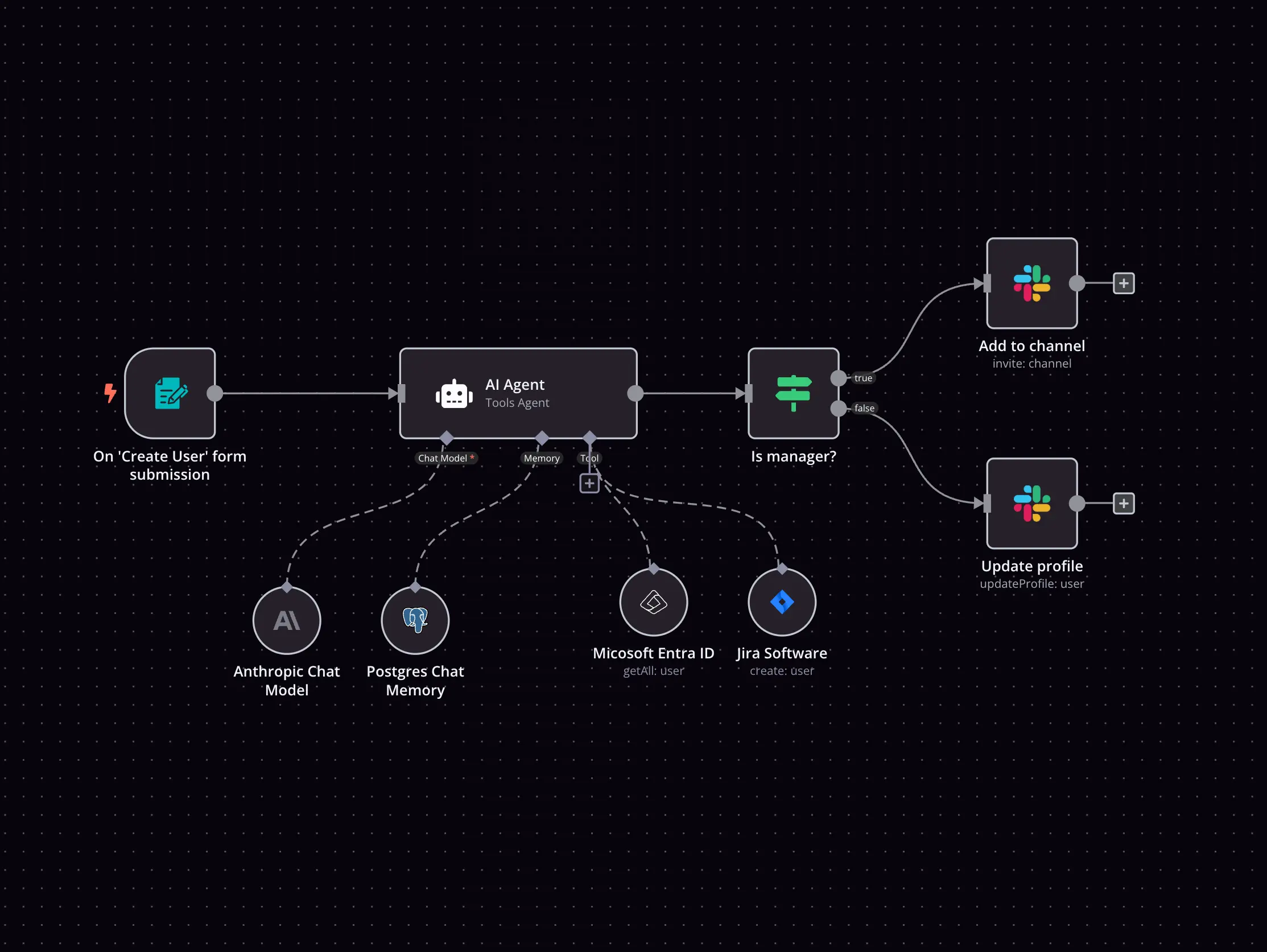Flotiq and Missive integration
Save yourself the work of writing custom integrations for Flotiq and Missive and use n8n instead. Build adaptable and scalable Development, workflows that work with your technology stack. All within a building experience you will love.


How to connect Flotiq and Missive
Create a new workflow and add the first step
In n8n, click the "Add workflow" button in the Workflows tab to create a new workflow. Add the starting point – a trigger on when your workflow should run: an app event, a schedule, a webhook call, another workflow, an AI chat, or a manual trigger. Sometimes, the HTTP Request node might already serve as your starting point.
Build your own Flotiq and Missive integration
Create custom Flotiq and Missive workflows by choosing triggers and actions. Nodes come with global operations and settings, as well as app-specific parameters that can be configured. You can also use the HTTP Request node to query data from any app or service with a REST API.
Supported API Endpoints for Flotiq
List content types
Retrieves a list of all content types available.
Create content type
Creates a new content type.
Update content type
Updates an existing content type.
Get single content type
Retrieves details of a specific content type.
Delete content type
Deletes a specific content type.
Create content type
Create a new content type definition.
Get content type
Retrieve a specific content type definition.
Update content type
Update an existing content type definition.
Delete content type
Delete an existing content type definition.
Create content type
Creates a new content type for the application.
Update content type
Updates an existing content type in the application.
List content types
Retrieves a list of all content types available in the application.
Get single content type
Retrieves a specific content type by its ID.
Delete content type
Deletes a specified content type from the application.
Create content type
Creates a new content type definition via API.
Update content type
Updates an existing content type definition.
List content types
Retrieves a list of content type definitions.
Get single content type
Retrieves a single content type definition by ID.
Delete content type
Deletes a specific content type definition by ID.
List content objects
Retrieves a list of all content objects.
Create content object
Creates a new content object.
Update content object
Updates an existing content object.
Get single content object
Retrieves details of a specific content object.
Delete content objects
Deletes a specific content object.
Create content object
Creates a new content object in the application.
Update content object
Updates an existing content object in the application.
List content objects
Retrieves a list of all content objects available in the application.
Get single content object
Retrieves a specific content object by its ID.
Delete content object
Deletes a specified content object from the application.
List deleted content objects
Retrieves a list of all deleted content objects.
Create content object
Creates a new content object based on a content type.
Update content object
Updates an existing content object.
List content objects
Retrieves a list of content objects.
Get single content object
Retrieves a single content object by ID.
Delete content object
Deletes a specific content object by ID.
Retrieve content object
Retrieve the schema of a specific Content Object by sending a GET request.
Delete content object
Delete a specific Content Object identified by its ID.
Retrieve GraphQL schema
Retrieve the GraphQL schema that describes your data.
Execute GraphQL queries
Execute GraphQL queries to retrieve specific data.
Get blogposts
Retrieve details of blogposts content type.
Create content type
Create a new Content Type Definition in the system.
Update content type
Updates the definition of the specified content type using a PUT request.
Update blogposts
Updates the schema definition for blog posts.
To set up Flotiq integration, add the HTTP Request node to your workflow canvas and authenticate it using a generic authentication method. The HTTP Request node makes custom API calls to Flotiq to query the data you need using the API endpoint URLs you provide.
See the example hereThese API endpoints were generated using n8n
n8n AI workflow transforms web scraping into an intelligent, AI-powered knowledge extraction system that uses vector embeddings to semantically analyze, chunk, store, and retrieve the most relevant API documentation from web pages. Remember to check the Flotiq official documentation to get a full list of all API endpoints and verify the scraped ones!
Supported API Endpoints for Missive
Reopen conversation
Reopens the current conversation.
Assign users
Assigns users to the current conversation.
Create draft
Creates a new draft in a new conversation.
List conversations
List conversations visible to the user who owns the API token.
Get conversation
Fetch a specific conversation using the conversation id.
List messages
List messages in the conversation passed as `id`.
Create conversation
Creates a new conversation.
Archive conversation
Archives a specified conversation.
Trash conversation
Moves the specified conversation to trash.
Move to inbox
Moves the specified conversation back to inbox.
Comment on conversation
Adds a comment to a specified conversation.
Create task
Creates a new task related to a conversation.
Add labels
Adds labels to the specified conversation.
Remove labels
Removes labels from the specified conversation.
Close conversation
Closes a specified conversation.
Reopen conversation
Reopens a specified closed conversation.
Assign conversation
Assigns a specified conversation to a user.
Add assignees
Adds assignees to a specified conversation.
Remove assignees
Removes assignees from a specified conversation.
Set color
Sets color for the specified conversation.
Set subject
Sets the subject of the specified conversation.
Fetch conversations
Fetches attributes for the given conversation IDs.
Create conversation
Creates a new conversation.
Archive conversation
Archives current conversation.
Trash conversation
Trashes current conversation.
Move to Inbox
Moves current conversation to Inbox.
Create comment
Creates a comment in the current conversation.
Add labels
Adds labels to the current conversation.
Remove labels
Removes labels from the current conversation.
Close conversation
Closes the current conversation.
Create draft in current conversation
Creates a new draft in the current conversation.
Reply to conversation
Replies to current conversation latest message.
Forward message
Forwards current conversation latest message.
Insert text
Inserts content as text in the currently selected composer.
Insert HTML
Inserts content as HTML in the currently selected composer.
Create draft
Creates a new draft in Missive.
Create report
Create analytics report
Get report
Get analytics report
Create contact
Creates new contacts in the contact book.
Update contact(s)
Update existing contacts with new information based on their IDs.
List contacts
Retrieve a list of contacts stored in Missive.
Get a contact
Fetch a specific contact using the contact ID.
List contact books
List the contact books that the authenticated user has access to.
List contact groups
List contact groups or organizations linked to a contact book.
Create message
Create an incoming message in a custom channel.
Get message
Fetch a specific message headers, body and attachments using the message id.
List messages
Fetch messages matching an email Message-ID.
Fetch messages
Fetches attributes for the given message IDs.
List organizations
List organizations the authenticated user is part of.
Create post
Create a post in a conversation or append it to an existing one.
List responses
List responses for the authenticated user.
Get response
Fetch a specific response using the response id.
List shared labels
List shared labels in organizations the authenticated user is part of.
List teams
List teams in organizations the authenticated user is part of.
List users
List users in organizations the authenticated user is part of.
Fetch users
Fetches attributes for all users.
Get stored data
Retrieve data that has been previously stored using storeSet.
Set stored data
Store data that remains consistent between page reloads and app reloads.
Fetch labels
Fetches attributes for all shared labels.
Create task
Creates a task in the current conversation.
To set up Missive integration, add the HTTP Request node to your workflow canvas and authenticate it using a generic authentication method. The HTTP Request node makes custom API calls to Missive to query the data you need using the API endpoint URLs you provide.
See the example hereThese API endpoints were generated using n8n
n8n AI workflow transforms web scraping into an intelligent, AI-powered knowledge extraction system that uses vector embeddings to semantically analyze, chunk, store, and retrieve the most relevant API documentation from web pages. Remember to check the Missive official documentation to get a full list of all API endpoints and verify the scraped ones!
Flotiq and Missive integration details
FAQ
Can Flotiq connect with Missive?
Can I use Flotiq’s API with n8n?
Can I use Missive’s API with n8n?
Is n8n secure for integrating Flotiq and Missive?
How to get started with Flotiq and Missive integration in n8n.io?
Looking to integrate Flotiq and Missive in your company?
The world's most popular workflow automation platform for technical teams including
Why use n8n to integrate Flotiq with Missive
Build complex workflows, really fast


